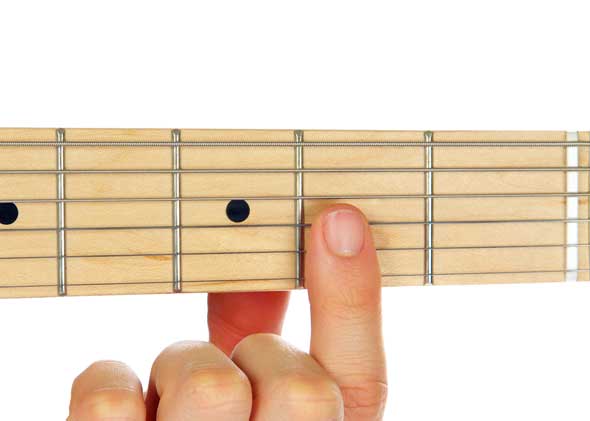
Major Seventh Chords
Another chord type you will need to know is the major seventh.The major seventh chord symbol is maj7. Here are the six most common open chord shapes for maj7 chords.
C Major Seventh Chord

Cmaj7

To play the Cmaj7 chord, strum all six strings. Notice that the Cmaj7 chord shape is just a C chord shape with the first finger lifted off.
The following chord progression contains the C major seventh chord and uses sixteenth note strums in the third beat of the rhythm pattern. Use pivot fingers when changing between Cmaj7 to Am and Dm to G7.


Guitar Effects…

The Whammy Bar
The tremolo arm or "Whammy Bar" can be used to produce a variety of sounds on the electric guitar, ranging from subtle vibrato on chords to dramatic bends, harmonics and "dive bombs". There are several different types of whammy bars fitted to all types of electric guitars. These include Fender, Bigsby and Floyd Rose. Use of the whammy bar was first thoroughly explored by Jimi Hendrix who brought many new sounds into music.
F Major Seventh Chord

Fmaj7

To play the Fmaj7 chord, strum all six strings. The Fmaj7 chord shape is just an F chord without the F note on the 1st string.
The following chord progression contains Fmaj7 chords and uses sixteenth note Rhythm Pattern 11. Use a pivot finger when changing between Fmaj7 and Dm.



Dotted Eighth Notes

Another common sixteenth note timing is when a sixteenth note is played after a dotted eighth note, i.e.:

The dot placed after the eighth note lengthens the note by half its value. The dotted eighth note is equivalent to the duration of three sixteenth notes, i.e.:




G Major Seventh Chord

Gmaj7

Strum all six strings to play this Gmaj7 chord shape. The X above the 5th string indicates that note is not in the chord and is deadened. In this chord shape, the second finger of the left hand lightly touches the 5th string, which deadens it, so even when you strum the 5th string it makes no sound.
Apply sixteenth note Rhythm Pattern 8 to the following chord progression. Practice the chord progression using an easy rhythm pattern before using the suggested pattern.


A Major Seventh Chord

Amaj7

Strum all six strings. The Amaj7 chord shape is an A chord shape with the first finger playing the first fret instead of the second fret.
In the following progression, use your first finger as a slide between all chord changes. The first finger does not lose contact with the 3rd string throughout the entire progression. The two bar rhythm pattern combines quarter, eighth, sixteenth, and silent strums.


D Major Seventh Chord

Dmaj7

Strum only five strings. Use the first finger to bar all three notes on the 1st, 2nd and 3rd strings of the second fret.
Practice the chord changes with an easy rhythm pattern before using the suggested rhythm pattern.


E Major Seventh Chord

Emaj7

Strum all six strings. The Emaj7 chord shape is the same as the E chord shape except for the note on the 4th string.
The following chord progression contains all the major seventh chord shapes learned in this lesson. Practice this progression with an easy strum pattern first. Once you are confident with the chord changes, use the suggested rhythm pattern.




Know your Guitars…

Know Your Guitars…
Along with the Fender Stratocaster, the Gibson Les Paul is one of the most famous of all electric guitars. It is great for heavy Rock sounds as well as being versatile enough for Blues and Jazz. This guitar was made specially for Les Paul - a great Jazz player who also invented multitrack recording. This technique is essential for recording and is now used by everyone from top recording studios to musicians using computers at home.